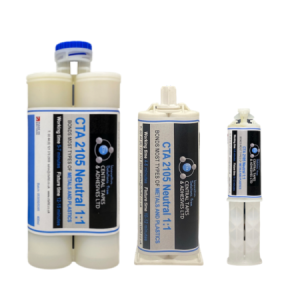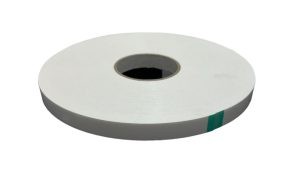Here are the most frequently asked questions (FAQs) about our single and two-part adhesives, tapes and seam sealer. If you don’t find an answer to your question here, then contact us via the chat box or our contact form. You can also call us on 0121 378 2909.
Single part adhesives FAQs
1. What are the differences between single and two part adhesives?
Single part adhesives can be used straight from the tube with no mixing, metering or degassing. They require heat, moisture or solvent evaporation for curing. Single part adhesives have an initiator; a heating element contained within the resin. To reach full cure, some single part adhesives require an oven, another heating mechanism, solvent evaporation or moisture absorption.
Two part adhesives cure at room temperature. Typical cure times are five minutes working time and then a 15 minute fixture at an ambient temperature of 16-25°C (60-77°F).
2. What are the benefits of using single part adhesives?
One of the main benefits of using single part adhesives is that there is no mixing required, which simplifies the process. Therefore, single part adhesives eliminate waste and accelerate productivity. Single part adhesives also remove concerns over mix ratios, weighing, working life and shelf life.
Single part adhesives offer outstanding performance properties, long-term durability and easy application. For more information about the single part adhesives we offer, visit our single part adhesives page.
3. When should I use single part adhesives?
You can use single part adhesives when bonding, sealing, coating and potting. You can also use single part adhesives for encapsulation and impregnation applications.
4. What is adhesive curing?
Adhesive curing takes place when the single part adhesive is placed in an oven with a temperature above 130°C. Curing develops the adhesion, forming a strong bond.
5. Where would I use single part adhesives?
Typical applications of single part adhesives include applications in the electronic, aerospace, medical, electrical, automotive, oil and chemical processing and optical industries.

Two part adhesives FAQs
1. Why would I use two part adhesives?
You can use two part adhesives for structural bonding applications requiring very high tensile and shear strength. Two part adhesives are a particularly effective solution for bonding metal to metal, as well as bonding engineered plastics and composites together.
2. What are the benefits of two part adhesives?
The benefits of two part adhesives include their high tensile and shear strength. Two part adhesives are able to fill gaps up to 10mm wide, while maintaining structural strength and characteristics. Two part adhesives come in a variety of open / working times from 5 minutes to 50 minutes with a fixture time of 12 mins to 120 minutes. Also, two part adhesives offer long-term environmental durability.
For more information, visit our two part adhesives page for more details.
3. When should I use two part adhesives?
You can use two part adhesives to bond metal to metal, or with engineered plastics or composites where a strong bond is required.

Tapes FAQs
What tape should I use for high temperature applications?
We recommend 6110 ,6118, 6189 & 61122R Double Sided High Performance tapes for high temperature applications, suitable for both internal and external applications, temperature range from -30°C to 200°C. Various widths and thicknesses available.
What tape can I use for an invisible bond?
6110 is a double sided high performance foamed acrylic gel tape that is Optically Clear, perfect for applications involving glass, acrylic and Perspex or where a bond is required to look invisible. It bonds well to both high energy (HSE) and low energy (LSE) surfaces.
Why would I choose to use tape instead of adhesive?
If speed is of the utmost importance it might be wise to choose tape. Tape has an instantaneous stickiness without the need for curing. Tape can also be less messy as there is no need for special tools to apply it.
What tape can be used for high initial tack?
We recommend our Double Sided Auto grade grey foam tape 6118 which has a higher initial tack and an excellent initial wet out, ideal for when a permanent high strength is required.
What tape can be used for colder temperatures / applications?
We recommend our Double Sided Auto grade grey foam tape 6118 to cope with colder temperatures
What is high initial tack?
High initial tack is provided by tapes and adhesives and means that heavier weights can be supported and held without slippage during the assembly process.
What is wet out?
When the tape/adhesive settles into the surface of the substrate.
What tape can be used for low surface energy applications?
61122R Tape can be used for fixing and bonding low energy substrates, various rigid plastics and painted or powder coated metals in electronics, construction, extrusion, sign making and automotive industries. The tape is good for difficult to bond plastics, has high initial tack and a temperature range of -20°C to +180°C.
What tape is best for metal bonding?
6189HT is 0.8mm thick, double sided acrylic tape and ideal for high strength metal bonding. It has a temperature range of -40°C to +200°C, plus very high shear and tensile strength.
What tape is best for bonding in the cold?
Some tapes do have a tendency to harden in the cold, thereby losing form and tackiness. To overcome this you should choose a tape that has been engineered and designed to work in cold weather. Many of our structural tapes have wide temperature ranges, some allowing application in temperatures as low as –40°C. Find the tape that is ideal for you by visiting our tapes selector page
How is bonding tape applied?
Preparation is key, ensure surfaces are clean, dry and free of any dirt, dust or grease. We recommend using CTA IPA Cleaner Degreaser. Use sufficient pressure over the whole surface at room temperature to ensure maximum adhesion to substrates. Primers can increase bond performance and surface tension. We recommend CTA Primer or CTA UV Identifiable Primer for best results. Ensure uniform stress distribution.
What tape provides the best weather resistance?
6110 ,6118, 6189 & 61122R are all very high performance foamed tapes, very high-density, foamed acrylic tapes with acrylic adhesive both sides, range in thickness and available in various colours and widths. This combination makes these specialist high specification, double sided tapes ideal for exterior applications, able to cope with temperature, weight and give a long strong reliable bond.
What tape can I use for light weight applications?
5110 is double sided closed cell PE foam tape with excellent adhesive and holding power. It is 1mm thick with acrylic adhesive. This product would be suitable for lightweight interior and also exterior applications such as signage, PVC extrusions, Georgian bars, number plates and more.

Seam sealer FAQs
1. What are the benefits of using seam sealer?
There are many benefits of using seam sealer. For example, there is no mixing required for a single part adhesive. Seam sealer fills gaps and seals seams in metal panels prior to being put through an oven bake cycle. The metal fabricators can spot-weld stainless steel panels and fill gaps. Seam sealer reduces welding time and speeds up production. It becomes very strong when cured in an oven.
In addition, seam sealer is over-paintable, it has minimal odour and minimal shrinkage. It is non-flammable and has excellent weather resistance against sunlight, rain, snow and temperature extremes. Seam sealer is available in black and white, and is easy to apply.
For more information about our seam sealer products, read our seam sealer case study or visit our page Pre powder coat seam sealer
2. When should I use seam sealer?
You can use seam sealer when preparing aluminium panels prior to paint or powder coat. You can use seam sealer to bond car and bus panels quickly. Also, you can use seam sealer to confidently bond stainless steel stiffeners to panels prior to paint cycles in the cladding and commercial façade industries. It is an ideal solution for filling gaps and sealing in industrial manufacturing. Seam sealer also prolongs the life of car repairs following restoration.
3. What is seam sealer for cars?
You can apply seam sealer directly onto metal. It prevents moisture seeping through the seams of a car, which prevents the potential corrosion that can occur when water and moisture get into the vehicle. Seam sealer is useful for any automotive joint, structural and non-structural, which is not going to be too visible. You can use seam sealer wherever panels join together.
For the best results, make sure to use seam sealer after applying an epoxy primer and smooth the product out. CTA currently provide a Primer and a UV identifiable primer for hard-to-bond surfaces. It is always a good idea to prepare surfaces using a degreaser, such as our IPA cleaner degreaser.
4. Is seam sealer paintable?
Yes, seam sealer is paintable. Seam sealer should be applied as a bead and then smoothed out for the best effect. Apply seam sealer and pass it through an oven, so that it is cured and becomes paintable. If the sealant was smoothed out well you should be able to paint over it.
5. How do I use seam sealer?
Always clean and dry panels before applying seam sealer. Bead some seam sealer onto the seam and then, making sure you are wearing latex gloves first, smooth out the product with your fingers, or with a brush. Be mindful to ensure that you totally seal the gap, as even small flaws can lead to failure.
When using seam sealer on something that will not be visible be liberal and spread it out well.
6. Where would I use seam sealer?
You can use seam sealer in any application where two panels require bonding. Typical applications include automotive bodywork, heavy duty vehicles and farm equipment, metal fabrications and metal facades.

If you didn’t find an answer to your question here, then please contact us via the chat box or contact form. You can also email us directly with your query at [email protected] or call us on 0121 378 2909.
